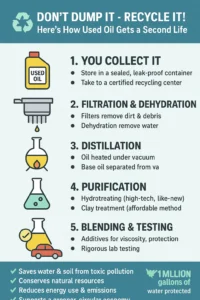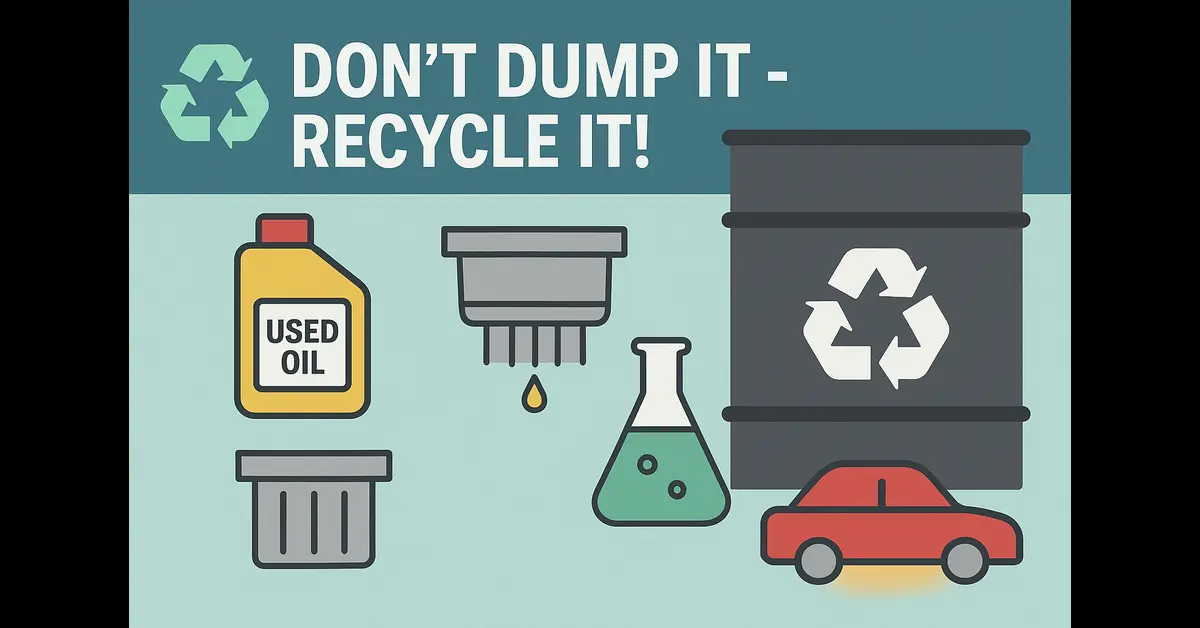Every year millions of liters used oil are put into the ground without care, contaminating the soil, contaminating waterways and threatening wildlife. But what a lot of people don’t realise is that such harmful waste could be transformed into a useful resourcethrough recycled oil.
A gallon of discarded oil could end up polluting up to a million gallons of clean water. On the other hand that gallon, when properly recycled, can be used to make top-quality lubricants and fuels and even construction materials.
The greatest part? It is easy to help in this eco-friendly change. Here’s a complete walk-through of the process that happens to oil used beginning from the time that you take it to a recycle facility until it’s returned in a usable form -and why you shouldn’t miss this easy but powerful green procedure.

How Used Oil Recycling Saves the Planet
Step 1: Safe Collection and Aggregation
The process starts with the person who is collecting the oil from a source e.g car, machine or any equipment. If it’s coming from your car mower, motorbike, lawnmower or industrial equipment used oil should be stored in the form of a sealed and leak-proof container. Do not put it in the drain, onto the floor, or into the regular garbage bins.
After that, the auto shops and factories drop it off at designated collection locations or recycling facilities for the community. Specialized vehicles transfer the oil in a safe manner to recycling facilities, ensuring no spills or leaks damage the environment on the way.
Pro Tip: Always store used oil in a separate container – mixing it with solvents, antifreeze or chemicals can make recycling more difficult.
Step 2: Filtration and Dehydration
After the recycling facility the oil gets “cleaned out.”
- Filtration eliminates metal shavings, as well as others solid impurities.
- Dehydration gets rid of water resulting from condensation or exposure to the storage environment.
The initial purification is crucial. In the absence of it, the crude will be insufficiently contaminated for further processing. Heating is commonly used to speed up evaporation to prepare the oil further refinement.
Step 3: Distillation – Separating the Good From the Bad
Then comes the process of vacuum distillation in which the oil is heated in order to break it into its constituents.
- The lighter fractions (like oil for fuel) are the first to evaporate.
- Larger fractions, like asphalt residues, are left in the background.
- The primary prize here is the base oil — the primary material used to create new lubricants.
This is like crude oil refining, but it focuses on recovering useful products rather than extracting new ones.
Step 4: Advanced Purification – Hydrotreating or Clay Treatment
The distillate oil is still loaded with impurities (sulfur nitrogen, sulfur, and metals). In order to make the oil “like new” facilities employ:
- Hydrotreating is a high-tech procedure which uses catalysts and hydrogen under pressure to eliminate the most impure elements. It produces oil nearly the same as the base oil that is virgin.
- clay treatment An easier and more economical method of treatment where absorbent clays remove contaminants.
Both methods produce premium base oils that can be used in the industry.
Step 5: Blending and Quality Testing
The purified base oil won’t be enough. To function as new, it’s combined with ingredients to restore the properties of critical components:
- Viscosity to ensure smooth flow
- Anti-wear agent for engine protection
- Resistance to oxidation for long-lasting durability
Every batch is thoroughly examined for viscosity, flash point and cleanliness prior to re-entry into the market.
Step 6: Repurposing and Reuse
Finally, the oil that was recycled gets a new purpose:
- As engine oils for trucks, cars and other machines
- In the form of Industrial fuels for boilers and burners.
- In fact, they are the components are used in asphalt to construct roads
This means less demand to extract petroleum from fresh sources and a lower use of energy and less emission of greenhouse gases. It’s a win-win situation for the environment as well as the economics.
Why YOU Should Recycle Your Used Oil Today
- Here’s the reason this simple step is crucial:
- Stops harmful chemicals from contaminating soils and waterways
- Conserves natural resources through decreasing the demand for crude oil
- Reduces energy consumption (recycling consumes much lower energy and less than refining the new oil)
- Encourages the idea of a cycle economy in which waste is transformed into an asset
Take a look doing something as simple as conserving your oil in a proper manner and then bringing your oil for recycling facility could help protect ecosystems, ensure drinking water and help to create a more sustainable future.
How to Start Recycling Used Oil at Home
- Drain and collect Following changing the oil, pour the old oil into a new and leak-proof container.
- Cap It Check that the cap is secure to stop leaks.
- Do not mix Do not blend oil in with any other fluids for cars or with chemicals.
- Drop it off Locate your closest certified recycle center or auto shop which accepts used oil.
- Repeat Create it into an everyday routine — similar to recycling glass, plastic or paper.
Final Word
Recycling used oil is more than waste management. It’s about changing a major environmental problem into a sustainable resource. Everyone — whether car proprietors to large industries play a part in this process.
When you next replace your engine, keep in mind: don’t dump it instead recycle the oil! You’ll be protecting the environment, preserving the natural resources and fueling the future of a more sustainable tomorrow.
Disclaimer: This article is intended for informational use only. Be sure to follow local laws or regulations and guidelines when dealing with or recycling used oil. Consult your municipal authority or certified recycling centers to determine the proper disposal method within your region.
